Argument "Maxim Smertin"
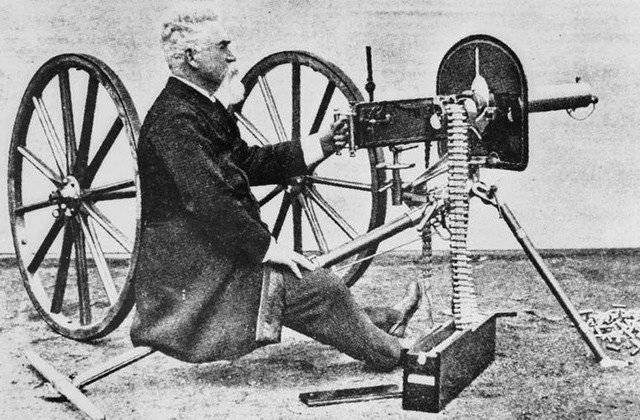
History the creation and service of the most famous machine gun of the Great War
The Maxim machine gun is one of the most recognizable symbols of Russia in the era of the Great War and the subsequent revolution. But from a military history point of view, this is actually not very fair. The fact is that the "Maxims" were the main machine gun not only in the Russian army. Armed with its main enemy - Germany - they stood several times more, and only the design of additional devices there was different, which made them not as recognizable as the Russians. However, these circumstances do not detract from the merits of "Maxim".
For simplicity and reliability, the soldiers at the front affectionately called him "Maximushka." He had other, more severe folk nicknames - “Maxim Vorunchov”, “Grandpa Vorchun”, “Maxim Smertin”. Sometimes it was only this machine gun that allowed the Russian soldiers to hold positions that were completely hopeless for defense. Even the German military machine, famous for its impeccable offensive tactics, began to show hesitancy and slip when 7,62-mm “arguments” of “Maxim Smertin” flew towards her.
The oldest and forever young
The technical idea of the machine gun, no doubt, belongs to the Americans. In 1862, American designer Richard Gatling invented the Gatling gun - armory a system of several alternately charged trunks, driven by the rotation of a special handle. In France, this type of weapon received the name Mitraleza, and in Russia - Gatling's card case, since the first versions of this weapon were fired with cartridges loaded with two or three buckshots.
The commercial success of the Gatling gun launched an avalanche-like reaction to the development of automatic weapon systems - mainly among the inventors who lived in America. In one of his studies, the well-known Russian armament expert, Semyon Fedoseyev, lists a long list of R. Gatling's followers who patented their own automatic weapon systems: Pilon (1863), Curtis (1866), Miller (1869), Plessner (1872), Willer and Luce (1874), Fasold and Savage (1877). With the exception of the latest development, all these systems remained unclaimed defense structures of the leading states of the time.
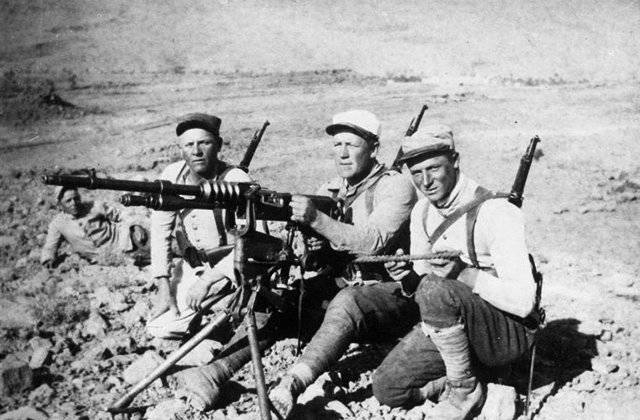
In 1884, French-American Hiram Stevens Maxim offered his own automatic weapon system for the British 11,4-mm rifle cartridge. The system worked on the principle of automatics with a short stroke recoil, had a number of characteristic signs of the “Maxim” popular in many armies of the world in the future: a parallel pair of pivotally connected swing arms in the bolt group, a casing for a liquid barrel cooling system, and a cloth cartridge belt.
In 1888, for the production of his machine gun, Hiram Maxim, moving to the UK, teamed up with the Swedish engineer Torsten Nordenfeld, who had a well-equipped gun factory near London. The formed company Maxim-Nordenfeld managed to secure the favor of the Rothschild & Sons banking house, and therefore had a significant financial resource for the development and comprehensive testing of the machine gun being created.
Torsten Nordenfeld turned out to be a very useful partner in promoting the first versions of the Maxim machinegun: the Swede equipped the machinegun with differently designed weapons using his own design - field, serf and sea. This allowed for the first time in world practice to give the machine gun Maxim multifunctional.
In 1897, the production of the machine gun "Maxim" has received a new development. By this time, the prospect of significant government orders for machine guns of this system became quite obvious. Evidence of this was the business success of the company "Maxim-Nordenfeld" - the production of the machine gun joined the major concern "Vikkers & Sons." For some time (until 1904), the machine guns of the Hiram Maxim system produced in the UK were called the Maxim-Vikkers system. In the same period, the inventor is constantly working to increase the reliability and simplicity in the maintenance of automatic machine guns. At the end of the 1899 of the year, at the field tests the Maxim-Vikkers machine gun for the 303 British rifle cartridge was able to make 15 consecutive thousands of shots without a single technical delay.
German full house
A genuine triumph awaited Hiram Maxim's armory in Germany. The young emperor Wilhelm II, who was seriously interested in technology, was young with a quick clear mind and highly appreciated the Maxim machine gun when it was first viewed. The first small series was immediately purchased, and in 1889-1890, the Maxim machine gun passed complex tests in the German armed forces. Already in 1892, the large mechanical plant Ludwig Leve and Co. began industrial production of the Maxim machine gun for the German army under license from the Maxim-Nordenfeld company.
“German industry,” notes S.L. Fedoseev, with its first-class metallurgy and precision engineering, was perhaps best prepared for the mass production of automatic weapons. It is not surprising that some sources call Germany the place where Maxim machine guns began to be produced, although the United Kingdom was really such. ”
Subsequently, German military analysts were able to properly assess the fact that more than half of the Japanese losses in the Russian-Japanese war 1904-1905 were ensured by the effective work of the Russian Maximov. As a result, the production of this machine gun in Germany was really massive: only one German army received more than 12,5 thousand such machine guns by the beginning of the Great War, and by the end of the world war the Germans already had 100 thousands of Maxims. In the German weapon indexing system, Maxim received an MG-08 index, and due to very high-quality barrel machining on German machine tools, its practical range increased by 400 meters (2400 meters against 2000 in the Maxim version of Tula).
The British and French estimated the highest combat effectiveness of the Maximov much later. The French, in spite of their 1892 order of the year for the Maxim machine gun with a saddle pack - for the French Ministry of Colonies, generally “looked over” its unique combat and technological qualities. In the years of the Great War, the main French machine gun became a much less efficient, but at the same time, very naughty in operation Gunchis M 1909-1914 machine gun.
Although the UK officially adopted the Maxim-Vickers machine gun as early as 1891, the total number of machine guns of this design in the British armed forces barely reached 5 thousands by the beginning of the First World War. The extraordinary effectiveness of these weapons became clear to the British strategists only during the Dardanelles operation, which was inglorious for them.
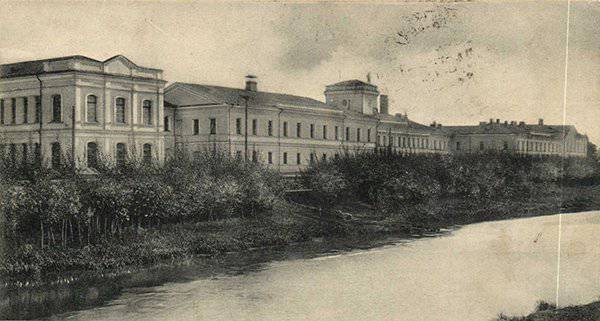
25 April 1915, an allied Anglo-French assault force attacking the Gallipoli peninsula in the Aegean Sea from the sea, came under the concentrated fire of the Maximov 5 of the Ottoman army. The German advisers very skillfully placed the machine guns in position: the Allies lost about 18 thousands of people killed and wounded only on the first day of the landing operation. English General G.G. Kitchener then called the machine gun Hiram Maxim "tool devil."
Russian tests
Imperial Russia in terms of the creation and procurement of new weapons rarely tried to outrun the leading countries of Europe. The Russian military department usually reflected on the novelties already adopted by Western countries, trying to choose the best from several competing systems. In Russian practice, the “best” weapon never meant the most high-tech or possessing higher combat capabilities in comparison with competitors, but always more technologically simple and most unpretentious in operational terms. For any decision of the Russian Chief Artillery Directorate of the General Staff (GAU), the foggy image of an illiterate Russian conscript from peasants always loomed, for which even the Mosin rifle, dismantled into seven parts, was incredibly complex.
Compared with Germany, the Russian procedure for adopting new models was also incredibly long, and sometimes painful, especially for foreign contractors. In this sense, the long epic with the armament of the Russian army with the Maxim-Vikkers machine gun is very revealing, because it lasted more than 10 years.
For the first time, Maxim’s automatic system came into the view of the Russian military department in 1885, and the feedback from the specialists of the Artillery Committee of the Main Artillery Directorate (GAU) on this machine gun was negative. It was noted that the Maxim system cannot compete in reliability with the Gatling cartels in service with the Russian army.
However, in the 1887, Maxim’s “rapid-fire guns” tests were continued. Three machine guns were installed in St. Petersburg, installed on new tripod machines designed by Nordenfeld. The conducted field shooting showed that the automatic operation of the machine gun leaves much to be desired: “Maxims” could not shoot a full cartridge belt (333 cartridge) without any delays.
The following year, the 4,2-linear (11,43-mm) "Maxim" was shown to Emperor Alexander III. 8 March 1888, the Russian autocrat personally shot from this machine gun in the arena of Anichkov Palace.
As pointed out in his study by Fedoseyev, in the same 1888 year, in the period from 7 to 23 in May, Maxim's machine guns passed complex experimental firing at the Main artillery range near St. Petersburg. The tests were not very successful - sometimes the recoil energy was not enough for the reliable operation of the automation. As a result, the decision to purchase a machine gun was not made. One "Maxim" from this series was then transferred "to strengthen" the Pamir detachment of the Russian army, where he served until 1900.
The interest in the machine gun of Hiram Maxim, shown at the beginning of the last decade of the nineteenth century by the German General Staff, sharply spurred Russian interest in it. In 1891-1892, the Russian military department purchased from the Maxim-Nordenfeld company a small series of five machine guns for the 3-linear (7,62-mm) Russian rifle cartridge (7,62 R).
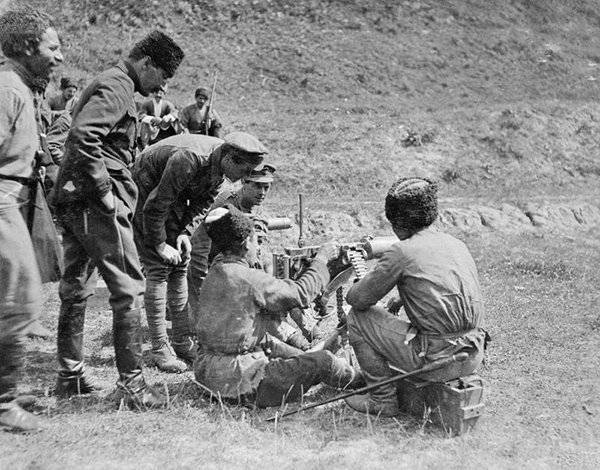
The new version of "Maxim" worked significantly better. According to experts, this was due to the installation of a special retractor amplifier amplifier in the system. This technical innovation appeared thanks to the joint efforts of the officer of the Main artillery range, Captain N.N. Zhukov and weapons technology company "Maxim-Nordenfeld" Y.H. Miller. Subsequently, the muzzle amplifier was installed on all Maxim-Vikkers machine guns not only in Russia, but also in foreign countries.
Ten years of rearmament
In the 1895 year, Maxim's 3-linear automatic machine guns included the rearmament of Russian fortresses into the general plan. A special meeting on defense, gathered in February-March 1895, recognized the need to have an 24 machine gun in the "composition of the special Black Sea stock of guns in the Odessa Military District." After that, long negotiations began on the price of a single product with the firm Vickers, Sons and Maxim.
The process was not easy: the British, as befits a nation of merchants, frantically desperately, steadfastly fighting for every pound. The “break through” deal was helped by the offer of the Berlin company “Ludwig Leuve and Co.”. The Germans agreed to supply machine guns at the price of 5 930 marks (around 290,25 pounds sterling). Only after that “Vikkers” agreed to the price of 300 pounds sterling (at that time around 2 830 rubles) for a machine gun complete with a machine, machine gun belts and charging boxes.
Taking into account this proposal of the British, the Russian GAU decided to order 150 machine guns for fortresses and 24 for a special stock - all on fortress carriages, complete with spare parts. The deal was "the highest approved" only 31 May 1896, that is, the process of ordering the first mass batch of machine guns went almost a year.
Subsequently, the Russian military department several times bought the Maxim-Vikkers machine guns in relatively small batches. The order for these weapons was also received by the German company “Deutsche Waffen und Munischenfabriken” (DWM).
At the beginning of 1904, in connection with the outbreak of the war with Japan, it was decided to expand the production of Maxim machine guns in Russia. 9 March 1904 of the year with the company "Vikkers, Sons and Maxim" signed a compensation contract, according to which the British received 80 pounds sterling for each machine gun produced on Russian machine tools.
The contract stipulated that Vickers would supply all technical documentation to Russia during the 3 months: technological drawings and the so-called “exemplary” machine gun, and within 6 months it would transfer the complete series of factory patterns and the nomenclature of the steels used. It should be noted that the British took full advantage of the desperate need of the Russian army for machine guns: for ten years of “testing” and endless coordination within the Russian military department, Russia was now paying with a genuine gold ruble. Military experts believe that the cost of compensation payments to Vickers was almost twice the amount of possible payment per unit of production if the compensation contract was concluded in peacetime, and not in the conditions of the outbreak of war.
In view of the fact that Great Britain was an ally of the Japanese Empire, the transfer of documentation from Vickers was delayed under various pretexts. As military historians note, only the decisive threat of breaking the contract with the transfer of his Germany prompted the British to fulfill their obligations. 7 August 1904, the Imperial Tula Arms Factory (ITOZ) finally received the blueprints and specifications for the project, and in October a model machine gun was obtained from London. The first state order in 175 products was closed by the Tula Arms Plant in the middle of 1905.
"God knows the machine guns, Tretyakov and the Shepherds" - such a saying appeared among the workers of the Tula Arms Plant after 1905. It is connected with the names of the master-gunsmiths Pavel Petrovich Tretyakov and Ivan Alekseevich Pastukhov, who introduced the “Maxim” into production at the ITOP.
The central place in this triad (after God, of course) belongs, of course, to Tretyakov, the head of the tool shop of the Tula Arms Plant. According to completely different sources (which, apparently, testifies to its objectivity), the Russian Maxim, produced at ITOZ, turned out better than the English Maxim-Vikkers: more technological in manufacturing, more reliable in operation and, of course, much cheaper. This can hardly be surprising: Tula prepared their machine gun for use on the Russian front by the hands of Russian soldiers.
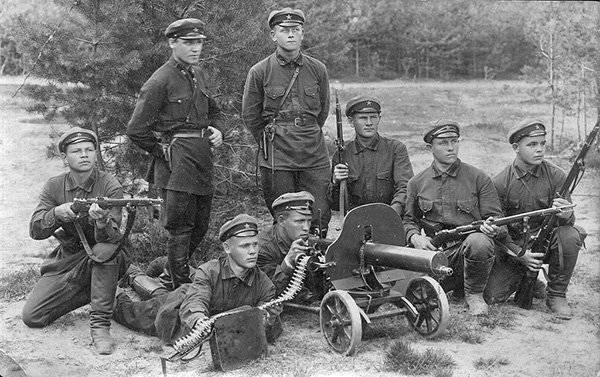
In 1910, the Maxim of Tula equipped a colonel A.A. with a new field wheeled machine. Sokolova. The machine was heavy (more than 40 kilograms), but allowed to significantly reduce the profile of the vertical elevation of the machine gun, and most importantly, allowed the machine gun to be quickly moved to a new firing position with little time to prepare for firing.
Long life of Russian "Maxim"
Despite the fact that almost 1905 years passed from the middle of 1914 to August 10, Russia entered the Great War with a minimum number of Maximov 4 157 machine guns. (For comparison, as already mentioned, the German army on 1 August 1914 had more than 12,5 thousand MG-08 machine guns, similar to the Russian Maxim.)
This fact vividly illustrates the obvious: the Russian generals, unlike the Germans, could not fully comprehend the field experience of the Russian-Japanese war, which Russia itself was leading. Subsequently, the military science patriots from military science tried to explain this very unpleasant circumstance for the Russian General Staff to those in the military department there was a discussion on determining the best type of machine gun for the army and the field machine for it. If this is true, then the pace of a truly Russian “discussion” is impressive: 10 years (from 1895 to 1905 year) discusses the type of machine gun, and then 5 years - the expediency of having a particular machine gun in the army.
The very first days of the war revealed a huge demand for machine guns. The Main Artillery Directorate (GAU) decided to increase their production at the Tula Arms Plant in 1914 year to 80 units per month, and from 1 in January 1915-th to 200 units per month (2400 - per year).
By 1, January 1915, the entire Russian army had 4 985 “Maxim” machine guns - slightly more than the plans of the General Staff had envisioned on the eve of the war, but extremely insufficiently, based on the realities of military operations against the Central Powers.
Taking into account the requirements of the front, the Supreme Command Headquarters determined the need for 1916 year in Maxim machine guns in 14 072 units. This decision prompted the Main Artillery Directorate to set the production rate of machine guns in 800 units per month. At the existing facilities of the Tula Arms Plant, it was impossible to ensure compliance with this standard. It was possible to increase the productivity of ITOZ by tremendous tension: the machine park was increased by 800 machines, and the number of toolmakers was almost doubled.
The mobilization of production allowed in a fairly short time to significantly increase the performance of the machine-gun department of the Tula plant. If for the entire 1914 year at ITOZ 1 161 machine gun was made, then in 1915 year 4 124 entered the army. In the next 1916, the Maximov edition went up to 11 172 units and, finally, in 1917, 11 420 machine guns were produced.
The performance of the machine-gun department of the Tula Arms Plant was able to raise almost 9 times. However, the merciless Moloch of the World War demanded more and more batches of weapons: the volumes of weapons that at the beginning of 1914 seemed fantastic, by January 1917 caused only a sad smile.
At the end of January, 1917, the Headquarters demanded that 28 thousands of machine guns be put into the army, in addition to this it was proposed to allocate at least 10 thousand Maxims to the weapons supply. The leadership of the army demanded that GAU purchase overseas 110 thousand guns (light machine guns) and at least 10 thousand Colt system machine guns abroad. Manual machine guns, as the war showed, were the most effective field weapons in the offensive, but the Russian army practically did not have this type of weapon on the front.
Having received this "wish" rate, GAU immediately threw out the "white flag": even bringing the performance of the Tula Arms Plant to 2 700 machine guns per month seemed to military specialists an unattainable goal. A special meeting on defense, which had become an unwilling appendage to the war ministry by 1917, attempted to encourage Russian entrepreneurs to manufacture Russian machine guns. However, the Russian industrialist, with very few exceptions, turned out to be eager before the intermediary supplies of military equipment produced in the West to the army, but he was not eager to deploy weapons production facilities.
In the end, the need to replenish the machine-gun fleet forced the military department to place several orders for machine guns, equipment and ammunition for them abroad. By the end of 1917, Russia received 8 590 from the Allies in the Entente, and 1917 33 machine guns from the United States (which entered the war only in April 808 of the year). It’s impossible to determine how many of these weapons accounted for by the American “Maxim” and the English “Vickers”, since the exact data on the nomenclature of the systems of machine guns supplied to the Russian army was not preserved. It can be assumed that the purchases of analogues of the Russian Maxim were relatively insignificant (in the first place, of course, scarce light machine guns were purchased).
It is important to emphasize that the greatest saturation of machine guns of the Russian infantry units was achieved only by the beginning of the 1917 of the year. In this respect, the Russian army was more than double in its 1915-1916 opponents, and in the 1917 year, despite the best efforts of Russian gunsmiths, it was almost 3,5 times.
The Maxim machine gun continued to be produced in Soviet Russia at the Tula and Izhevsk factories until the end of the 40 of the XX century. There is evidence that the last combat use of a machine gun on Russian territory occurred in 1969 during the border Soviet-Chinese conflict on Damansky Island. Abroad, the machine gun was manufactured much longer: in the middle of the 60 of the last century, the repair of the Maxim machine guns, as well as the piece-making of these weapons, could be ordered in Mexico and Argentina.
Information